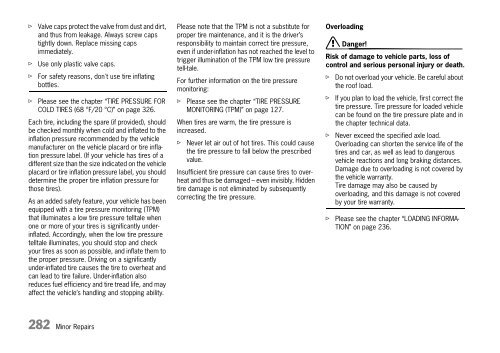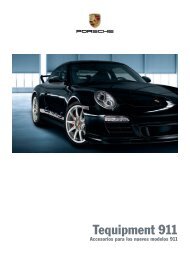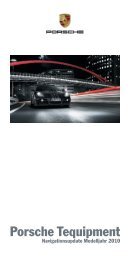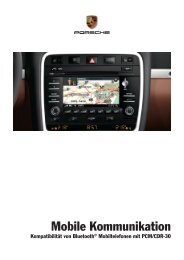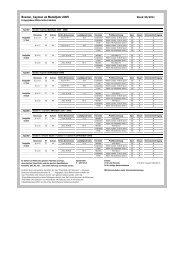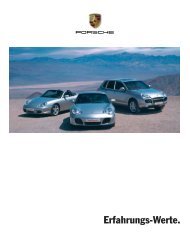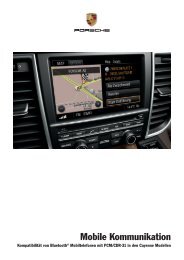You also want an ePaper? Increase the reach of your titles
YUMPU automatically turns print PDFs into web optimized ePapers that Google loves.
f Valve caps protect the valve from dust and dirt,<br />
and thus from leakage. Always screw caps<br />
tightly down. Replace missing caps<br />
immediately.<br />
f Use only plastic valve caps.<br />
f For safety reasons, don't use tire inflating<br />
bottles.<br />
f Please see the chapter “TIRE PRESSURE FOR<br />
COLD TIRES (68 °F/20 °C)” on page 326.<br />
Each tire, including the spare (if provided), should<br />
be checked monthly when cold and inflated to the<br />
inflation pressure recommended by the vehicle<br />
manufacturer on the vehicle placard or tire inflation<br />
pressure label. (If your vehicle has tires of a<br />
different size than the size indicated on the vehicle<br />
placard or tire inflation pressure label, you should<br />
determine the proper tire inflation pressure for<br />
those tires).<br />
As an added safety feature, your vehicle has been<br />
equipped with a tire pressure monitoring (TPM)<br />
that illuminates a low tire pressure telltale when<br />
one or more of your tires is significantly underinflated.<br />
Accordingly, when the low tire pressure<br />
telltale illuminates, you should stop and check<br />
your tires as soon as possible, and inflate them to<br />
the proper pressure. Driving on a significantly<br />
under-inflated tire causes the tire to overheat and<br />
can lead to tire failure. Under-inflation also<br />
reduces fuel efficiency and tire tread life, and may<br />
affect the vehicle’s handling and stopping ability.<br />
282 Minor Repairs<br />
Please note that the TPM is not a substitute for<br />
proper tire maintenance, and it is the driver’s<br />
responsibility to maintain correct tire pressure,<br />
even if under-inflation has not reached the level to<br />
trigger illumination of the TPM low tire pressure<br />
tell-tale.<br />
For further information on the tire pressure<br />
monitoring:<br />
f Please see the chapter “TIRE PRESSURE<br />
MONITORING (TPM)” on page 127.<br />
When tires are warm, the tire pressure is<br />
increased.<br />
f Never let air out of hot tires. This could cause<br />
the tire pressure to fall below the prescribed<br />
value.<br />
Insufficient tire pressure can cause tires to overheat<br />
and thus be damaged – even invisibly. Hidden<br />
tire damage is not eliminated by subsequently<br />
correcting the tire pressure.<br />
Overloading<br />
Danger!<br />
Risk of damage to vehicle parts, loss of<br />
control and serious personal injury or death.<br />
f Do not overload your vehicle. Be careful about<br />
the roof load.<br />
f If you plan to load the vehicle, first correct the<br />
tire pressure. Tire pressure for loaded vehicle<br />
can be found on the tire pressure plate and in<br />
the chapter technical data.<br />
f Never exceed the specified axle load.<br />
Overloading can shorten the service life of the<br />
tires and car, as well as lead to dangerous<br />
vehicle reactions and long braking distances.<br />
Damage due to overloading is not covered by<br />
the vehicle warranty.<br />
Tire damage may also be caused by<br />
overloading, and this damage is not covered<br />
by your tire warranty.<br />
f Please see the chapter “LOADING INFORMA-<br />
TION” on page 236.


